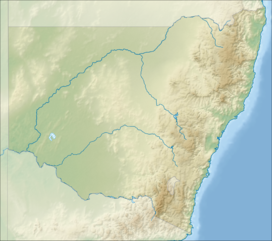Prospect Hill (New South Wales)
| Prospect Hill | |
|---|---|
| Prospect Lookout, Marrong Reserve, Greystanes Hill, Pemulwuy Lookout | |

Lookout from Prospect Hill (Pemulwuy Lookout), which displays the Sydney skyline.
|
|
| Highest point | |
| Elevation | 117 m (384 ft) |
| Coordinates | 33°49′30″S 150°55′5″E / 33.82500°S 150.91806°ECoordinates: 33°49′30″S 150°55′5″E / 33.82500°S 150.91806°E |
| Dimensions | |
| Length | 3 km (1.9 mi) North/South |
| Naming | |
| Native name | Mar-rong |
| Geography | |
| Country | Australia |
| State | New South Wales |
| Region | Greater Western Sydney |
| District | Blacktown City Council |
| Geology | |
| Type of rock | Laccolith |
Prospect Hill is a hill in Pemulwuy, New South Wales about 30 kilometres west of central Sydney. It is higher than the ridges of the Cumberland Plain around it and has steeper slopes. Its present-day highest point is 117 metres high, although before its summit was quarried away it rose to a height of 131 metres above sea level.
Prospect Hill is a “nodal point” of the Cumberland Plain. Its summit affords a “goodly prospect” west to the Blue Mountains and east to the man-made landmarks of central Sydney. People have walked round and over Prospect Hill for 30,000 years and have recognised it as a landmark, a meeting place and a boundary. It was known to local people as Mar-rong or Mur-rong in 1790.
For today's Australians it has historic significance, aesthetic values and commercial values. There are extensive industrial and housing developments on its slopes. The hill has a number of summits, with Marrong Reserve being the most popular for visitors.
The hill has historical significance as one of the first places in the fledgling colony of New South Wales where liberated convicts were granted land to farm. Furthermore, the settlement on Prospect Hill were a focus of significant ambivalence between the indigenous people and the white settlers throughout the 1790s. For over 180 years quarrying of the volcanic rocks for roadstone and other building materials has been an important activity.
The first recorded ascent of Prospect Hill by a colonist is that of Captain-Lieutenant Watkin Tench and his party on 26 June 1789. While there is no documentary evidence of Tench having named Prospect Hill, there is no doubt that it is in fact the hill that was shortly afterwards known by that name. In view of Tench's literary allusions to Milton's Paradise Lost, it seems highly probable that the experience of climbing it reminded him of the "goodly prospect of some forein land first-seen" by Milton's scout and that it was indeed Tench who first named it.
...
Wikipedia

